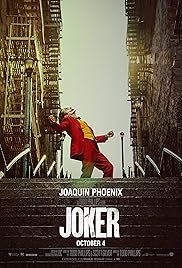Society is the Joke
By Ram Charan and Tejas Raghuram
A Film Review of Joker (2019) directed by Todd Philips
Joker (2019), directed by Todd Phillips and starring Joaquin Phoenix, tells the story of Arthur Fleck, a working class lad with a disorder that causes him to laugh in awkward situations and how he slowly gets pushed over the edge by society to become the notorious Joker. While the film doesn’t pull its story from any one Batman comic run, it incorporates scenes from the most famous Joker stories. The most prominent example of this is the infamous talk show scene towards the end of the film, which is of course take its inspiration from The Dark Knight Returns. In addition to this obvious example, there are many more subtle references that give the film a layer of rewatchability.

Arthur Fleck finds it nearly impossible to think positive thoughts. Everything about his life comes crashing down after he is fired for carrying a gun into a children’s hospital. Everyone thinks he is a freak, primarily because of his mental illness which causes him to laugh in inappropriate situations. Without the right medication to treat his mental illness, Fleck is harshly judged by most.
His crazy mother who has a distorted sense of reality, even more so than him, makes matters much worse with her wild dreams of grandeur that Thomas Wayne will save them. As Fleck continues to scribble his wildest thoughts into his joke book, his madness grows in magnitude. He soon begins to question his very own existence. On the verge of collapse, Arthur Fleck finally attains confidence, meaning, and existence. His chaotic life pieces itself together as he adorns the make-up of the clown prince of crime. He finds meaning in killing others, proving that society has wronged him. He finds meaning in being the “Joker”.
Director Tood Philips brings Arthur Fleck’s instability and unreliability into focus by, throughout the film, revealing the discrepancies between Arthur’s perception of events and reality. Joker also uses brutal depictions of violence to allow the audience to reconsider the nature of Fleck’s mental state. For most of the film, the audience experiences things from Fleck’s perspective, but during these specific violent moments, you see Fleck for the person he is: a deranged psychopath who is a result of society’s ignorance. This experimentation with perspective is where the meaning of the film can be misconstrued.
This sympathetic portrayal of one of the world’s most famous sociopaths has led to some criticism of the film, calling it inflammatory and capable of inciting violence. However, when one understands that the film is partially existent within the mind of Arthur Fleck, the supposed “sympathetic” criticism of critics falls apart. While the film does portray Arthur’s descent into madness like a hero’s journey, the film takes the time to show both sides of the conflict, revealing the flaws of both.

It shows how the ruling class of Gotham, the city in which Joker is set, looks down on and trivializes the problems of the working class, through the character of Thomas Wayne. Wayne gives a speech during the film explaining that the only reason homeless people are still homeless is because they aren’t trying hard enough. At the same time, the film shows the negative effects of the violence caused by Joker’s revolution, with a pivotal scene involving the Wayne family outside of a certain theater that any Batman fan will know by heart.
Perhaps the most famous scene in the movie, the scene where Fleck dances down the stairs in full Joker makeup to the sound of Gary Glitter’s “Rock and Roll Part 2,” is another result of Fleck’s perspective. With a thunderous bassline behind him, Fleck descends into madness as he moves down the stairs. In all other parts of the movie, he is shown to be walking up the stairs, which were depicted as dreary and desolate. As he moves down the stairs, the supposedly upbeat tune shows his distorted sense of reality in how he thinks he is a savior. The descent represents a turning point in the film and the life of Arthur. It represents when he fully embraces the “Joker” personality and how he believes that his killing of members of the upper class is a rebellion against a city that morally corrupted him.

Of course, none of this would be worth much if not for Joaquin Phoenix’s absolutely brilliant performance, which is easily the best part of the film. Most actors bring a certain level of physicality to their roles, but Phoenix takes that idea to another level, truly transforming himself into the Joker. Phoenix was able to make the character of Arthur Fleck sympathetic, almost to the point of relatability, no matter how insane his actions really are. While some credit for this goes to writers Todd Philipps and Scott Silver, it is Phoenix’s line delivery that makes you care about his character. And of course, no portrayal of the Joker is complete without a properly bone-chilling laugh, and Phoenix is no slouch on this front, easily on the same level as Heath Ledger and Jack Nicholson, actors who once portrayed the Joker.
Overall Joker is a must watch for anyone that considers themselves a Batman fan, whether it be through the comics or the movies. With a stellar performance from Joaquin Phoenix and an intelligent script from Phillips and Silver, Joker delivers an emotional story with chilling social commentary.
